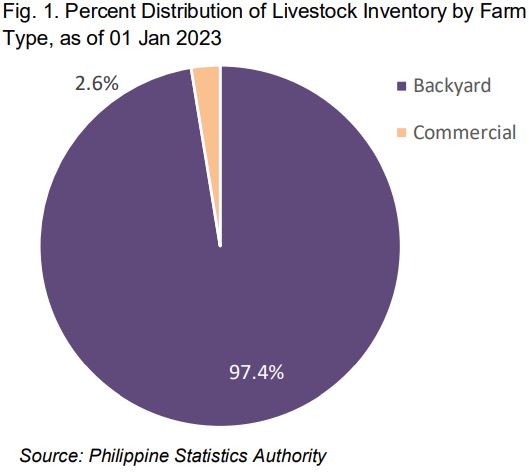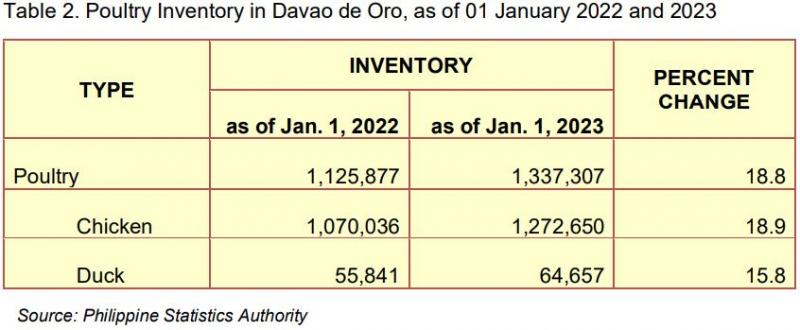Livestock inventory drops by 5.1 percent
As of 01 January 2023, the total inventory of livestock in Davao de Oro was registered at 181,182 heads. The total figure was 5.1 percent lower than the estimated 191,006 heads of the same period of last year.
The drop in the livestock inventory was mostly observed on backyard farms, 176,515 heads, or 4.6 percent lower than the previous year of 184,964 heads. Moreover, livestock raised on commercial farms also posted a negative growth of 22.8 percent, from 6,042 heads to 4,667 heads this year. In the province, 97.4 percent of livestock were raised on backyard farms while the remaining 2.6 percent were raised on commercial farms (Figure 1).
Livestock sector in the province comprised of carabao, cattle, goat, and swine of which all of the animal types as of 01 January 2023 had decreased inventories.
Among the livestock, swine has the highest decline in inventory, 6.8 percent, from 124,833 heads to 116,303 heads. This was followed by carabao, 19,176 heads from 20,325 heads; and cattle which registered 8,133 heads this year from 8,295 heads last year. Carabao and cattle inventories contracted by 5.7 percent and 2.0 percent, respectively. Only goat inventory, on the other hand, remained stable at 0.1 percent growth rate.(Fig 2).
In Davao de Oro, swine has the highest inventory, 64.2 percent of the total livestock. In the latest count of swine in the province, about 96.1 percent were tended on backyard farms while 3.9 percent were raised on commercial farms (Figure 3). Meanwhile, almost all of the carabao, cattle, and goat were tended on backyard farms.
Poultry inventory up by 18.8 percent
The province’s poultry sector comprised of chicken and duck. The poultry population grew by 18.8 percent, from 1,125,877 birds to 1,337,307 birds this year. Chicken had the major share in the overall inventory of poultry contributing to 95.2 percent, while the remaining 4.8 percent were ducks.
Broiler chicken largely contributed to the improvement in the total inventory of chicken, from 66,230 birds to 262,516 birds this year. This translates to a 296.4 annual growth rate. The layer chicken inventory also increased, by 16.3 percent. Native chicken, on the other hand, is the only type that had decreased its inventory this year, by 0.5 percent (Figure 4).
Among the types, the native chicken though decreased in inventory, had the largest share of stocks to the total chicken inventory with 73.1 percent or 930,575 birds. Broiler followed by exhibiting 20.6 percent. This contributed to 6.2 percent of the total chicken last year. Layer accounted for 6.3 percent of the total chicken this year.
Duck population in the province as of 01 January 2023, was recorded at 64,657 birds, 15.8 percent higher than the total inventory of 55,841 birds of the same period of last year. The growth was attributed to the increase in the number of ducks on commercial farms.
TECHNICAL NOTES
The Backyard Livestock and Poultry Survey (BLPS) and the Commercial Livestock and Poultry Survey are two of the four major surveys for livestock and poultry. The BLPS and CLPS are national surveys of which BLPS covers backyard farms on carabao, cattle, goat swine, chicken (broiler and layer) and duck in all four rounds. CLPS, on the other hand covers commercial farms on swine and chicken (broiler and layer) for minor rounds; and additional carabao, cattle, goat, and duck for major rounds.
Both surveys are important as the data generated will aid policymakers in generating sound policy decisions on the improvement of backyard and commercial farms for the welfare of the farmers and operators. Moreover, the survey will determine/measure the performance of the livestock and poultry industry and the agriculture sector, as a whole.
Livestock refers to farm animals kept or raised for consumption, work, or leisure. For purposes of censuses and surveys, livestock covers only those that are tended and raised by an operator.
Poultry is a collective term for all domesticated avians for the purpose of food consumption or, the carcass of such avian dressed/processed for human consumption.
Animal Inventory (also, Animal Population) is the number of domesticated animals in head present in the farm at specific reference date.
Commercial Livestock Farm/Operator refers to any livestock operator or farm which operation satisfies at least one of the following conditions: a.) at least 21 heads of adult and zero head of young b.) at least 41 heads of young animals c.) at least 10 heads of adult and 22 heads of young
Commercial Poultry Farm/Operator refers to any poultry operator or farm which operation satisfies at least one of the following conditions: a.) 500 layers, or 1,000 broilers b.) 100 layers and 100 broilers if raised in combination c.) 100 head of duck regardless of age
Backyard Farm/Raiser- refers to any farm or household raising at least one head of animal or bird and does not qualify as a commercial farm.
Starting April 2022 Round, CLPS shall cover all animal commodities: carabao, cattle, swine, goat, sheep, broiler, layer, and duck. The CLPS will use the results of the 2021 Updating of the List of Establishments (ULE) as sampling frame.








